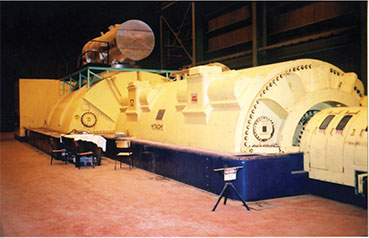Is On-Line PD Testing Useful for Hydrogen-Cooled Turbine Generators?
Turbine generators (TGs) in nuclear, coal, oil and some gas-fired plants tend to be rated above a few hundred megawatts. Such ma-chines tend be hydrogen cooled (and above 500 MW or so, both direct water- and hydrogen-cooled). Hydrogen-cooled TGs have many ad-vantages. Due to the small mass of the hydro-gen molecule, the efficiency of a hydrogen-cooled machine is higher than an air-cooled ma-chine, since there is less “windage” loss created by the spinning rotor. The absence of oxygen in the machine also means that aging processes that include oxidation do not occur and thus thermal aging is much slower. High pressure hydrogen is also much more effective than air in removing heat due to I2R losses in the rotor (and stator).
An important side effect of the use of high pressure (15 – 60 psi-g, or 100 – 400 kPa-g) hydrogen in TGs is that it will strongly suppress partial discharge (PD). The electrical breakdown strength of air and hydrogen are close. What makes the breakdown strength of the hydrogen so much higher is the pressure effect. It has been known for more than a century that electrical breakdown is strongly affected by the pressure of the gas. Most gasses have an electrical breakdown strength of about 3 kV/mm when dry and at 100 kPa. In contrast, if the pressure is 3 times higher, the breakdown strength is 9 kV/mm. The dramatic effect of pressure on breakdown results in the suppression of PD in high pressure hydrogen-cooled machines. So the questions often asked are:
- is PD a cause of insulation failure, and
- is on-line PD testing useful?
The short answer is no and yes, respectively.

PD is still sometimes present in hydrogen-cooled TGs in spite of the pressure effect. One reason PD still occurs is because such machines often are designed to run at higher operating voltage (up to 27 kV) and higher design average electrical stress (typically >3 kV/mm compared to air-cooled machines). That is, the manufacturers take advantage of the PD suppression properties of high pressure hydrogen, and re-duce clearances compared to air-cooled ma-chines. Also, certain types of degradation will still result in the electric fields needed to break-down high pressure hydrogen. But unlike in air-cooled machines, the PD itself will not meaning-fully degrade the insulation. The larger PD normally measured in air-cooled machines can slowly degrade epoxy (although it may take decades) – but more importantly, PD in air creates nitric acid that can chemically attack the insulation. This chemical attack phenomena is absent in hydrogen-cooled machines. In my experience, PD has never been the direct cause of failure in hydrogen-cooled machines.
So, is PD monitoring useful in hydrogen-cooled machines? Over 50 years of experience has shown that on-line PD testing can detect two important failure processes in hydrogen-cooled TGs:
- loose windings in the slot leading to slot discharge, and
- contamination of the stator end-windings by partly conductive materi-als such as oil mixed with dust/dirt that leads to electrical tracking.
In these cases PD is just a symptom that loose windings and contamination are present. Specifically, the PD is just a symptom, not a contributing factor to the rate of deterioration.
This ability to detect loose windings in the slot and contamination has been demonstrated in dozens of case studies published since the 1970s. PD being a symptom of these two deterioration processes is the reason that all major TG manufacturers offer on-line PD testing services (as well as Iris-Qualitrol). It should be noted, however, that on-line PD does not seem to be able to detect small water leaks into the insula-tion or endwinding vibration – two other im-portant causes of start winding aging/failure.

